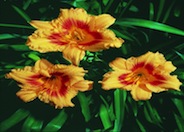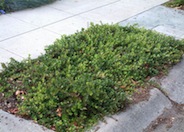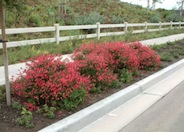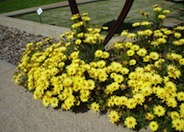
Common name:Black-Eyed Stella Hybrid Daylily
Botanical name:Hemerocallis 'Black-Eyed Stella'
This beautiful Daylily is stunning with a bright, yellow gold flower with a dark orange eyezone and dark green, grass-like foliage. This Daylily looks better in mass plantings. It reaches 2' tall and blooms in spring and sometimes summer. It prefers full sun and regular watering, with lots of compost and mulch.

Common name:Mexican Bush Sage, Velvet Sage
Botanical name:Salvia leucantha
The Mexican Sage is a bushy shrub that grows 3'-4' tall and wide. It has hairy white stems, gray green leaves and velvet-like purple flower spikes that bloom summer through fall. This shrub tolerates sun, light shade, little water, and is hardy to 15 degrees F. The Mexican Sage is drought tolerant and attracts hummingbirds. -Cornflower Farms

Common name:Bearberry
Botanical name:Arctostaphylos uva-ursi
A hardy, creeping evergreen shrub, it grows 6"-12" high and spreads as much as 10"-12'. It has glossy green leathery leaves attached to dark brown branches. Its flowers are white to light pink in late winter and early spring; berries are bright red.

Common name:Blue Star Creeper, Isotoma
Botanical name:Pratia pedunculata
Pratia pedunculata has bright green, nearly stemless, 1/4" leaves. In late spring and summer, these form a backdrop for equally tiny, star-shaped pale blue flowers.

Common name:Red Star Autumn Sage
Botanical name:Salvia greggii 'Red Star'
This shrub will grow 1'-4' tall and 1'-4' wide. It has glossy green leaves with red flowers that bloom from fall to spring.

Common name:Arctotis Daisy, African Daisy
Botanical name:Arctotis hybrids
African Daisy hybrids grow 12"-18" high and 12" wide; they produce daisy-like flowers from spring through summer. These hybrids have lobed leaves and bloom in white, pink, red, purple, cream and orange.

Common name:Pincushion Flower
Botanical name:Scabiosa caucasica
A perennial, this plant is a cushion-form groundcover or bedding plant. It grows to 1' to 2' tall, 2'-3' wide. White, bluish and lavender colored pompom-like flowers rise above the foliage.
Compost for Healthy Soil and Plants
The natural world works in cycles. Everything is changing form and moving from place to place in an endless energy exchange system. The leaves and twigs that fall to the ground, not to mention other life forms that might die, decompose and combine with water, air and minerals of the soil to create a medium for future plants.
Click in the green box for more information
| Designer: | Mockingbird Garden |
Photographer: GardenSoft |
Soils and Compost:
Incorporate compost 6" into your soil to retain water, reduce compaction, feed earthworms, and provide valuable nutrients to your plants.
Water Saving Tip:
Adjust sprinklers to avoid watering sidewalks and driveways.
Integrated Pest Management:
Remove irrigation water and fertilizer from areas where you don't want weeds to grow.

